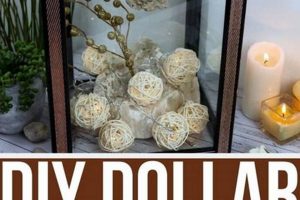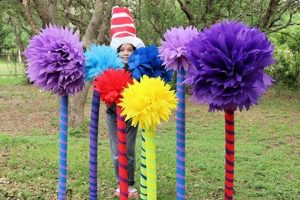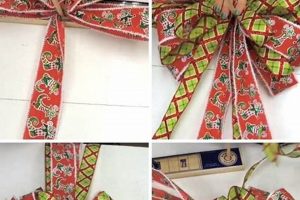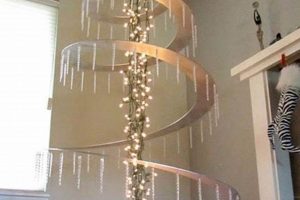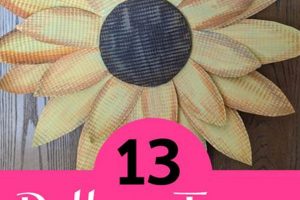Constructing a spooky seasonal dwelling using materials sourced from discount retailers like Dollar Tree, and following a do-it-yourself (DIY) approach, enables cost-effective Halloween decorating. This approach allows individuals to create custom haunted houses for indoor or outdoor display, utilizing readily available and inexpensive materials. As an example, one might use foam board from Dollar Tree to build the structure, then embellish it with paint, plastic spiders, and battery-operated lights, all purchased from the same source.
This cost-conscious decorating strategy democratizes the creation of elaborate Halloween displays. Individuals can engage in creative projects without significant financial investment, fostering community engagement through shared crafting experiences and the showcasing of homemade decorations. The historical context reveals a shift from commercially produced, often expensive, decorations to a resurgence in personalized, handcrafted displays, driven by both economic considerations and a desire for unique, individualized holiday experiences.
The subsequent sections will delve into specific project ideas, material sourcing strategies, and safety considerations when undertaking such endeavors. It will explore various techniques for achieving a high-impact aesthetic on a limited budget. Further discussion will be on the process of building the base structure, detailing the decorative elements and exploring tips for creating truly terrifying touches.
Tips for a Successful Dollar Tree Haunted House DIY Project
The following tips are designed to maximize the effectiveness and longevity of haunted houses constructed primarily from materials purchased at discount retailers. Careful planning and execution are crucial for a visually appealing and structurally sound result.
Tip 1: Structural Integrity is Paramount: Prioritize the creation of a stable base structure. Foam board, while inexpensive, can be fragile. Reinforce joints with hot glue and consider using cardboard or wooden supports for added stability, particularly for larger structures.
Tip 2: Paint is Your Best Friend: Inexpensive craft paints can significantly alter the appearance of Dollar Tree materials. Use dark base coats to create a more sinister atmosphere and employ dry brushing techniques with lighter colors to highlight textures and create a sense of age and decay.
Tip 3: Lighting Enhances Atmosphere: Battery-operated tea lights or LED string lights can add a dramatic and spooky ambiance. Consider using colored cellophane or tissue paper to diffuse the light and create a variety of eerie effects. Place lighting strategically to highlight key decorative elements.
Tip 4: Embrace the Imperfect: Part of the charm of a DIY haunted house is its handcrafted nature. Avoid striving for perfect symmetry or flawless finishes. Imperfections add to the overall sense of unease and authenticity. Purposefully uneven cuts and slightly askew decorations contribute to a more convincing “haunted” aesthetic.
Tip 5: Safety First: When using hot glue guns, exercise caution to avoid burns. Ensure all electrical components, such as battery-operated lights, are properly insulated and kept away from flammable materials. Secure the haunted house structure, especially if placed outdoors, to prevent tipping in windy conditions.
Tip 6: Maximize Dollar Tree’s Product Range: Strategically utilize Dollar Tree’s diverse inventory beyond traditional Halloween decorations. Items such as plastic tablecloths can be repurposed as cobwebs or ghostly draperies. Cleaning supplies, like sponges, can be cut and painted to create textured wall effects.
Tip 7: Bulk Buying is Beneficial: Purchase decorations in bulk for consistency and added value. This guarantees color matches for the structure. Spiders, bats, and spider webs can easily be made to fill your Haunted House using the same style and color of those purchased in bulk.
These guidelines emphasize the importance of structural stability, strategic use of paint and lighting, acceptance of imperfections, and adherence to safety protocols in the construction of haunted houses utilizing affordable materials. The strategic application of these principles yields more impressive and durable displays.
The next section will discuss the specific Dollar Tree materials most conducive to this type of project, as well as best practices for their efficient and effective use.
1. Affordable Materials
The viability of a “dollar tree haunted house diy” project hinges significantly on the availability and suitability of affordable materials. The cause-and-effect relationship is clear: the economic feasibility of constructing a sizable or elaborate haunted house depends directly on sourcing low-cost components. Without readily accessible and inexpensive materials, the project becomes cost-prohibitive for many individuals, negating the core principle of a budget-friendly Halloween display.
Affordable materials are not merely a component but a foundational pillar of this DIY approach. Dollar Tree, as a specific example, offers a range of items ideally suited for haunted house construction, including foam board for structural elements, craft paints for creating desired aesthetics, plastic spiders and webbing for thematic embellishments, and battery-operated lighting for atmospheric effects. The availability of these items at a consistent, low price point enables individuals to procure a sufficient quantity of materials to realize their creative vision without exceeding financial constraints. A real-life example demonstrates this: an individual successfully created a miniature haunted mansion using only Dollar Tree materials, spending less than $20, illustrating the practical significance of affordable materials in this context.
The understanding of this relationship is crucial for both individuals undertaking such projects and for retailers seeking to cater to the DIY Halloween market. By recognizing the demand for affordable materials, retailers can strategically stock relevant items, thereby facilitating the success of “dollar tree haunted house diy” endeavors. The inherent challenge lies in balancing cost with quality; materials must be inexpensive yet durable enough to withstand construction and display. In conclusion, the nexus of affordable materials and the specified DIY project allows for broad participation in Halloween decorating, democratizing access to creative and engaging seasonal experiences.
2. Creative Repurposing
Creative repurposing forms a crucial element within the context of “dollar tree haunted house diy.” The cause-and-effect relationship is demonstrable: limited financial resources necessitate innovative approaches to material utilization. The ability to transform everyday, inexpensive items into decorative or structural components of a haunted house directly impacts the overall cost-effectiveness and aesthetic originality of the project. Without creative repurposing, a “dollar tree haunted house diy” risks becoming either financially unsustainable or aesthetically uninspired.
The significance of creative repurposing lies in its capacity to elevate the perceived value and transform the function of common objects. For example, plastic tablecloths, typically used for disposable table coverings, can be manipulated to simulate cobwebs or ghostly drapes. Similarly, floral foam, intended for arranging flowers, can be sculpted and painted to resemble tombstones or grotesque architectural details. Dish soap bottles can form the base of monster figures. The effect of these techniques is that they can be used to add significant visual impact. Another instance is that by deconstructing cardboard boxes and reassembling them into structural supports and wall panels. These examples illustrate the transformative power of creative repurposing within the constraints of a limited budget, resulting in unique and visually compelling haunted house features.
In conclusion, creative repurposing is not merely a supplemental technique but an indispensable strategy for successful “dollar tree haunted house diy” projects. The understanding and application of this principle enable individuals to transcend the limitations of inexpensive materials and produce imaginative and engaging Halloween displays. The challenge lies in recognizing the potential within ordinary objects and developing the ingenuity to transform them into integral components of a cohesive haunted house theme. The effective implementation of creative repurposing ensures both the financial viability and the aesthetic distinctiveness of these DIY endeavors.
3. Structural Design
Structural design represents a foundational element within the context of “dollar tree haunted house diy.” The integrity and aesthetic presentation of a haunted house constructed from inexpensive materials are directly contingent upon sound structural planning and execution. A well-conceived structural design ensures both the stability and the visual effectiveness of the final product.
- Base Construction and Support
The creation of a stable base is paramount. Foam board, often the primary material in “dollar tree haunted house diy,” lacks inherent rigidity. Reinforcing joints with ample hot glue, utilizing cardboard corner supports, or incorporating lightweight wooden framing elements significantly enhances structural integrity. A poorly supported base risks collapse, particularly under the weight of decorative elements or during outdoor display.
- Dimensional Planning and Scale
Accurate dimensional planning is essential for maximizing material utilization and creating a visually appealing structure. Determining the desired scale of the haunted house beforehand allows for efficient cutting of foam board, minimizing waste and ensuring proportional relationships between different structural components, such as walls, roofs, and windows. Impaired scaling can result in an unconvincing or structurally unsound model.
- Weight Distribution and Load Bearing
Consideration of weight distribution is critical, especially when incorporating heavier decorative elements. Distributing weight evenly across the structure prevents localized stress points that could lead to structural failure. Strategically placed supports, particularly beneath heavy features like roofs or upper stories, are necessary to maintain stability. Improper loading can lead to collapse which may destroy the Haunted House and waste money.
- Material Adaptation and Reinforcement
Adapting design plans to the specific characteristics of Dollar Tree materials is imperative. Foam board, for instance, requires different construction techniques than traditional building materials. Reinforcement strategies, such as layering foam board or incorporating internal bracing, are crucial for compensating for the material’s inherent limitations. Failure to adapt designs leads to structural compromise.
The preceding facets underscore the critical role of structural design in “dollar tree haunted house diy.” A holistic approach that integrates robust base construction, precise dimensional planning, careful weight distribution, and strategic material adaptation ensures the creation of a durable and visually compelling haunted house, despite the use of inexpensive materials. These principles facilitate the transformation of humble supplies into a tangible and engaging Halloween display.
4. Atmospheric Lighting
Atmospheric lighting is paramount in elevating the impact of a “dollar tree haunted house diy” project. It transcends mere illumination, serving as a potent tool to evoke fear, suspense, and visual intrigue within a cost-constrained environment.
- Color Temperature and Emotional Response
The color temperature of lighting significantly influences emotional perception. Warm hues (yellows, oranges) can simulate flickering candlelight, creating a sense of unease and age. Cool hues (blues, greens) evoke a spectral, otherworldly atmosphere. Strategically alternating color temperatures within the haunted house amplifies the overall sense of disorientation and dread. This is seen by using colored light bulbs from a dollar store to emulate a haunted mansion.
- Shadow Play and Depth Perception
Skillful manipulation of light and shadow adds depth and mystery to the display. Focused beams of light create stark contrasts, highlighting key decorative elements while obscuring others in shadow. This technique generates visual uncertainty, prompting viewers to question what lurks in the darkness. A single flickering light can make dollar-store spiderwebs stand out.
- Movement and Dynamic Effects
Introducing movement to lighting amplifies its atmospheric effect. Battery-operated tea lights with flickering bulbs, readily available at discount retailers, simulate the erratic illumination of a dying flame. String lights with chase or fade functions can create a sense of impending doom. Motorized props paired with synchronized lighting effects enhance the dynamism and realism of the haunted house. String-lights behind white fabric can give a ghostly presence.
- Material Interaction and Light Diffusion
The choice of materials directly impacts how light is reflected and diffused. Translucent fabrics, such as cheesecloth or plastic sheeting, soften and scatter light, creating a ghostly or ethereal glow. Opaque materials, like painted foam board, block light completely, emphasizing shadow and contrast. Strategic layering of materials with varying degrees of translucence adds complexity and depth to the lighting scheme. This allows for more professional-looking and creative touches to a Dollar Tree Haunted House.
These facets underscore the indispensable role of atmospheric lighting in transforming a collection of inexpensive materials into a convincingly terrifying Halloween experience. Effective lighting techniques compensate for material limitations and amplify the psychological impact of the haunted house, establishing a genuinely immersive atmosphere. A well-lit haunted house makes for a scarier visual effect, and a bad lighting experience can ruin even the best decorations.
5. Spooky Decor
The effectiveness of any “dollar tree haunted house diy” project rests substantially on the quality and strategic deployment of spooky decor. The following details the facets of decor most relevant to this specific, budget-conscious application.
- Iconic Halloween Motifs
Sourcing readily recognizable Halloween symbols, such as skeletons, spiders, bats, and ghosts, is crucial for establishing an immediate sense of thematic coherence. These motifs, often available inexpensively at Dollar Tree, serve as visual cues that quickly communicate the intended spooky atmosphere. Repetitive use of these icons reinforces the theme, creating a predictable yet unsettling environment. A prevalence of skeletons and cobwebs immediately defines a “haunted” space.
- Textural Elements and Tactile Horror
Incorporating tactile elements enhances the immersive experience. Rough burlap, faux cobwebs, and plastic chains appeal to the sense of touch, creating a visceral connection to the haunted environment. Layering textures adds depth and complexity to the visual landscape, transforming otherwise mundane surfaces into unsettling sensory experiences. Using rough materials can give the haunted house a “old” or “unsafe” aesthetic.
- DIY Props and Customized Details
Creating custom props adds a layer of originality and personalization to the haunted house. Repurposing Dollar Tree items into unique decorations elevates the overall aesthetic beyond generic store-bought displays. Examples include transforming plastic skulls into eerie candle holders or crafting ghostly apparitions from cheesecloth and wire. Custom decorations can save money, and add a unique personality to the haunted house.
- Strategic Placement and Composition
The placement and arrangement of spooky decor elements are as important as the items themselves. Clustering decorations in key areas, such as entryways or dimly lit corners, maximizes their impact. Employing compositional techniques, such as the rule of thirds, enhances the visual balance and draws the eye to focal points. A disorganized scattering of decorations dilutes the intended effect, whereas strategic composition amplifies the sense of unease and foreboding. Proper placing is as important to the decoration themself.
These decor facets, when thoughtfully considered and implemented, transform a collection of inexpensive materials into a convincing and engaging Halloween experience. The success of a “dollar tree haunted house diy” hinges not only on the availability of affordable decorations but also on the creative and strategic deployment of these elements to evoke a palpable sense of horror and suspense.
6. Safety Measures
Safety measures constitute an indispensable component of any “dollar tree haunted house diy” project. The correlation between these two elements is straightforward: the potential for injury or hazard increases when constructing and operating a homemade haunted house, particularly when relying on inexpensive materials and potentially improvised construction techniques. Diligence in implementing safety precautions directly mitigates these risks.
The significance of safety measures stems from their protective function, guarding against physical harm and property damage. For instance, the use of hot glue guns, common in “dollar tree haunted house diy,” presents a burn hazard if mishandled. Ensuring proper ventilation during painting or using chemical adhesives prevents the inhalation of harmful fumes. Securing the structure against tipping, especially in outdoor settings, minimizes the risk of collapse and subsequent injury. An example highlights this: a poorly secured haunted house, constructed from lightweight materials, was toppled by wind, causing minor injuries to onlookers. This incident underscores the need for robust stabilization measures. Similarly, utilizing battery-operated lights reduces the risk of electrical shock compared to mains-powered alternatives. The practical application involves consistently adhering to established safety guidelines, such as wearing protective gloves and eyewear, ensuring adequate ventilation, and regularly inspecting electrical components for damage.
In summary, safety measures are not an optional addition but a fundamental requirement for any “dollar tree haunted house diy” endeavor. By proactively identifying and mitigating potential hazards, individuals can engage in creative projects responsibly, minimizing the risk of injury and ensuring a safe and enjoyable Halloween experience for themselves and others. The challenge lies in maintaining vigilance and consistently prioritizing safety throughout the entire process, from initial construction to final display.
7. Budget Conscious
The “dollar tree haunted house diy” concept inherently centers on the principle of being “budget conscious”. Resource limitations necessitate inventive resource allocation to maximize visual impact while minimizing expenditure. The economic constraints drive project design and material choices.
- Material Sourcing Optimization
Dollar Tree, the primary source for materials in this context, offers a limited selection of items at a fixed, low price point. Successful “dollar tree haunted house diy” projects necessitate meticulous inventory management to minimize waste and optimize material usage. This involves careful planning, precise measurements, and the strategic repurposing of materials to avoid unnecessary purchases. Example: Planning is a must for this because a successful Dollar Tree Haunted House is based on the availability of the products as well as how many will be purchased to keep the same style.
- Labor Cost Reduction
DIY projects, by definition, eliminate labor costs associated with professional design or construction services. However, successful “dollar tree haunted house diy” endeavors require efficient time management and skill acquisition to maximize output within a finite timeframe. This may involve learning new crafting techniques, delegating tasks among participants, and adhering to a realistic project timeline. Example: Proper research to make sure this project can be done with the time and people available.
- Design Simplification and Scalability
Elaborate designs often necessitate expensive materials and complex construction techniques. “dollar tree haunted house diy” projects typically involve simplifying design elements and scaling down project scope to align with available resources. This may involve prioritizing key visual features, omitting non-essential details, and focusing on creating a smaller, more manageable haunted house display. Example: Don’t try to add too much to the Haunted House as products may be harder to find or more expensive to make.
- Upcycling and Repurposing Strategies
The “budget conscious” ethos extends beyond initial material purchases to encompass the creative reuse of existing items. Successful “dollar tree haunted house diy” projects often incorporate upcycled materials, such as cardboard boxes, plastic containers, and fabric scraps, to reduce reliance on new purchases. This requires a keen eye for identifying potential repurposing opportunities and the skill to transform discarded items into decorative or structural elements. Example: Using items that are not decorations to create a decoration is a big part of DIY for this kind of project.
- Reuse Previous Supplies
The use of previous decorations from prior years. Reuse those decorations to save more money. This is a good way to not spend all that much when having a dollar tree haunted house diy.
The interconnected nature of “budget conscious” decision-making permeates every aspect of “dollar tree haunted house diy,” influencing material selection, construction techniques, design complexity, and overall project scope. An understanding of these principles is essential for realizing visually compelling and engaging Halloween displays within strict financial constraints. Maximization of low-cost resources is the main key to success.
Frequently Asked Questions
This section addresses common inquiries and misconceptions surrounding the construction of haunted houses using materials primarily sourced from Dollar Tree.
Question 1: Is it truly possible to construct a visually compelling haunted house using only Dollar Tree materials?
Yes, a visually compelling haunted house can be constructed using Dollar Tree materials, but it requires careful planning, creative repurposing of items, and skillful execution. The aesthetic impact is directly proportional to the effort and ingenuity invested in the design and construction process.
Question 2: What are the most essential items to purchase from Dollar Tree for this type of project?
Essential items include foam board for structural elements, craft paints for creating a spooky aesthetic, plastic spiders and webbing for thematic embellishments, battery-operated lighting for atmospheric effects, and hot glue sticks for assembly. Quantities depend on the scale of the project.
Question 3: How can structural integrity be ensured when using inexpensive and potentially fragile materials like foam board?
Structural integrity can be enhanced by reinforcing joints with generous amounts of hot glue, incorporating cardboard or wooden supports for added stability, and strategically layering foam board to increase its thickness and resistance to bending.
Question 4: Are there any specific safety precautions that must be observed during the construction process?
Yes, safety precautions are paramount. The use of hot glue guns requires caution to prevent burns. Adequate ventilation is necessary when working with paints or adhesives. Structures must be securely anchored to prevent tipping, especially in outdoor settings. Battery-operated lights are preferable to mains-powered alternatives to mitigate electrical hazards.
Question 5: What are some effective techniques for creating a convincingly aged or weathered appearance on Dollar Tree materials?
Effective techniques include applying dark base coats of paint, dry brushing with lighter colors to highlight textures, using sandpaper to create distressed edges, and staining materials with diluted coffee or tea to simulate age and decay.
Question 6: How much can one expect to spend on a typical “dollar tree haunted house diy” project?
The total cost varies depending on the size and complexity of the haunted house, but it is generally possible to construct a reasonably sized and visually appealing display for under $50, provided that materials are carefully sourced and frugally utilized.
These answers provide a foundation for understanding the potential, limitations, and best practices associated with constructing haunted houses using affordable materials. Careful planning and execution enable impressive results.
The subsequent section provides a conclusion of all the information discussed.
Conclusion
The preceding exploration elucidates the multifaceted nature of the “dollar tree haunted house diy” concept. It underscores the feasibility of constructing compelling Halloween displays through the strategic utilization of affordable materials. The success of these endeavors relies upon a synthesis of careful planning, creative resourcefulness, and diligent adherence to safety protocols. Furthermore, the preceding analysis highlights the interconnectedness of material sourcing, structural design, atmospheric enhancement, and decorative elements in achieving a cohesive and impactful final product.
As demonstrated, the constraints imposed by limited budgets necessitate innovative approaches and a meticulous attention to detail. The “dollar tree haunted house diy” aesthetic, therefore, represents a deliberate choice rather than a limitation, embodying a commitment to creative problem-solving and the democratization of seasonal decorating. The continued exploration and refinement of these techniques promise to further expand the possibilities within this budget-conscious realm, offering accessible avenues for individuals to express their creativity and engage in festive traditions.


